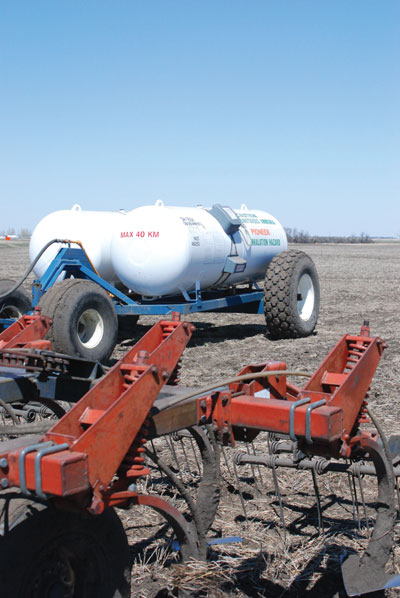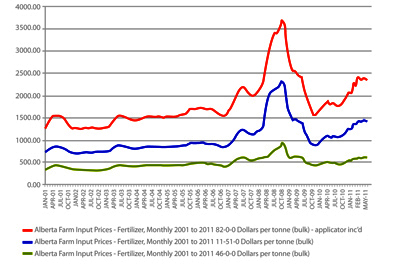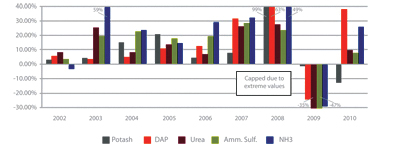
Features
Agronomy
Corn
Best time to buy fertilizer?
An elephant never forgets. Neither does a farmer.
November 17, 2011 By Donna Fleury
An elephant never forgets. Neither does a farmer. Although fall is traditionally the cheapest time to buy fertilizer, the extreme price drop from fall 2008 to spring 2009 has many farmers pondering whether pre-buying fertilizer this winter is a good idea.
 |
|
| Balance risk and reward when considering fall fertilizer purchase. Photo by Bruce Barker.
|
“In the fall of 2008, fertilizer prices were fairly high at about $690/tonne for urea, but prices collapsed in the spring of 2009,” explains Steve Larocque, president of Beyond Agronomy in Three Hills, Alberta. “We were stuck with expensive fertilizer costs and sub-par yields because of a dry growing season in 2009, adding to the cost. However, in most years buying fertilizer in the fall can be a good strategy. You have to weigh the costs and whether or not you are willing to risk $50 or $100/tonne increase on urea, for example, from fall to spring.”
Generally, pre-buying fertilizer in the fall can save growers money as compared to waiting until spring. Over the past couple of decades, other than for the two exceptions of 1976 and 2009, this has been the trend in Western Canada and the US. However, more recently, the market and fertilizer price volatility have growers, industry and researchers taking another look at when is the best time to buy fertilizer. Any price changes can have substantial impacts on farm profitability.
Historical trends from Western Canada illustrate the fall/spring price-spread. The Alberta Farm Input Prices Monthly Fertilizer tracking from 2001 to 2011, compiled by Alberta Agriculture and Rural Development (ARD), shows that fall fertilizer prices were lower except in the fall/spring of 2008/2009.
An in-depth analysis by researchers at Purdue University provides further insight into fertilizer price trends. The study, When to Purchase Fertilizer: A Comparison of Fall and Spring Prices, April 2011, looked at a common strategy that growers typically use of buying fertilizer in the fall rather than in the spring as a way to manage price variability. The study used retail fertilizer price data for the state of Indiana and resources from the USDA to calculate the percentage discount to fall fertilizer purchases.
The results were based on data over 38 years, from 1967 to 2009, and included information on five fertilizer types: DAP, urea, ammonium sulphate, anhydrous ammonia (NH3) and potash.
The Indiana analysis can be extrapolated to Western Canada. Prices in Canada are determined in a North American supply/demand market. Although the actual prices may vary, the trend is similar.
The Indiana study showed that only twice in the past 38 years, 1976 and 2009, were there considerable losses due to purchasing in the fall, irrespective of fertilizer type. Overall, anhydrous ammonia had the largest average annual discount to fall purchase at 12.35 percent overall, but substantial average annual discounts were observed for all of the fertilizer products.
The 2000s showed the largest discounts of any other decade for all fertilizer products, although the extreme price movements of 2008 and 2009 were not a new occurrence. The report says that on a percentage basis, some of the largest fertilizer price movements occurred in the 1970s.
The Indiana study calculated a percentage change from the October fall price to the April spring price. Except for the spring of 2009, positive fall discounts averaged 10 to 20 percent for five fertilizer products.
Storage, logistics and other considerations
If you are going to pre-buy fertilizer in the fall, Larocque suggests that one
option is to hedge your price risk. “It might be a good idea to offset a fertilizer purchase by pricing some of next year’s crop in the fall as a risk management tool, so you are not on the hook in case prices collapse and you are stuck with expensive fertilizer,” he says. “For example, on a 3000-acre farm that might purchase $200,000 of fertilizer, pricing a portion of next year’s crop can be a good idea.”
 |
|
|
Alberta farm input prices – fertilizeSource: |
|
 |
|
| Percentage discount to fall purchase, 2002-2010 Source: Indiana Fertilizer Retailer. |
Along with price, there are some other considerations growers need to think about when buying fertilizer, such as storage costs, logistics, opportunity costs and potential spring seeding risks. All of these factors are part of a grower’s risk management strategy.
“Storage costs vary from retailer to retailer, but typically a storage fee of $10/tonne per month is charged,” says Larocque. “For example, if you work out the interest cost per month on 100 tonnes of 46-0-0 worth $630/tonne at 5.5 percent interest, the cost is $2.89/tonne per month. If you store fertilizer for eight months, the interest cost would be $23.10/tonne. Therefore, if you feel fertilizer prices won’t climb by $23.10/tonne in the next eight months, then there is no use pre-buying fertilizer. However, few people can predict when fertilizer prices will go up, and if you can, you are hired!”
Larocque adds that some retailers also offer bin programs where growers share in the cost of the bin in exchange for storage. Logistics and fertilizer availability in the spring at the time of seeding is another consideration. Long lineups at the fertilizer shed can create downtime and cost some valuable seeding time.
“Another strategy that we have recently gone back to with good success is a two-pass system, which is another way to manage risk,” says Larocque. “We have gone back to applying NH3 in the fall on some of our land, using three-quarter-inch knives on 12-inch spacing, which minimizes soil disturbance. I’ve worked the numbers on a two-pass system to see if it actually makes sense and, yes, you’re typically money ahead with the difference in price between urea, storage costs and NH3. If you are applying 100 lbs of N/acre every year, you can usually save about eight cents a pound, which is an $8/acre saving that pays for the application. If you are not in an area that’s prone to flooding, fall NH3 application provides a low risk storage option in the soil and eliminates logistics issues in the spring.”
History shows that on average, purchasing fertilizer in the fall rather than waiting until spring can be a good strategy for saving money and managing price variability. Over the past decade, these price savings appear to have increased, which may create more incentive for fall purchasing of fertilizer.
However, market and price variability are likely to continue, and growers will have to manage fertilizer pricing as part of their overall farm risk management strategy.